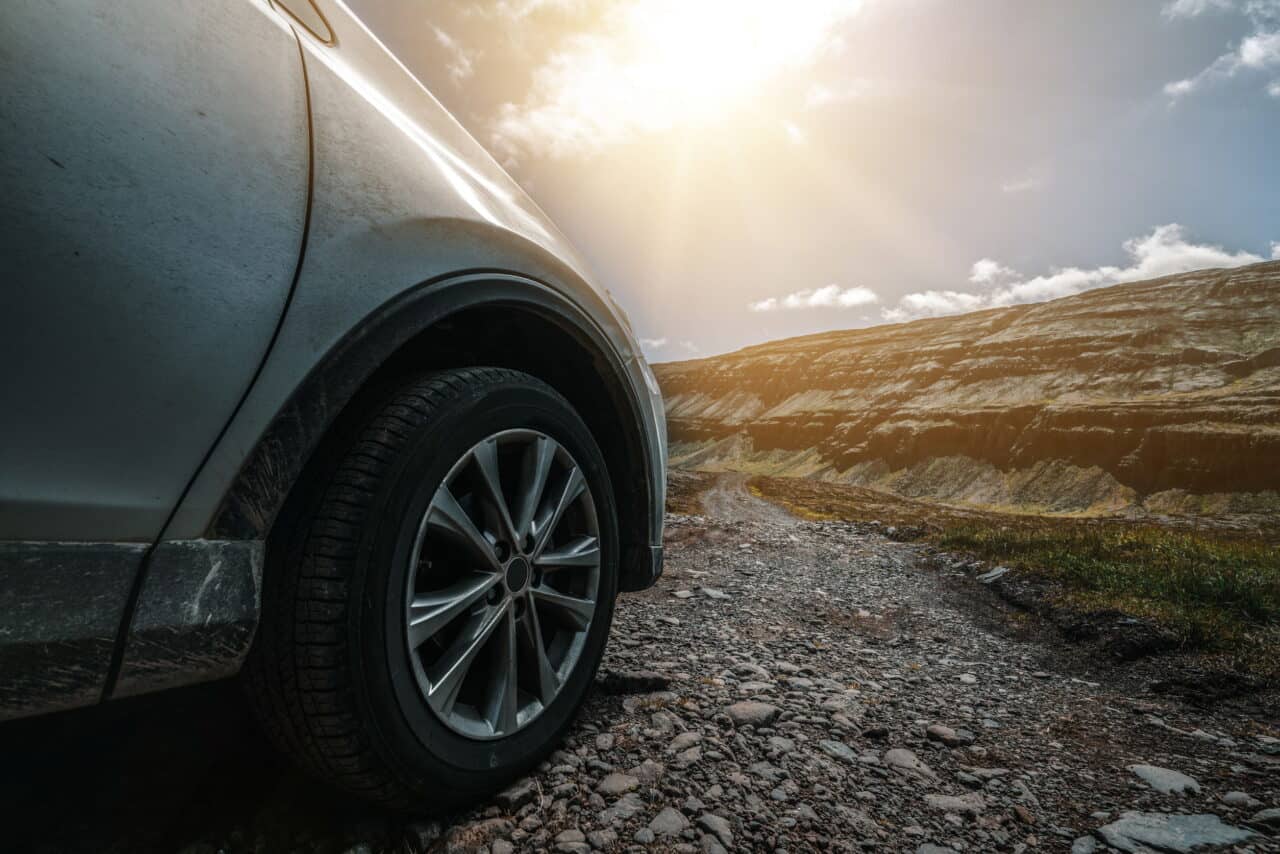How Do I Put My Lexus GX 460 is 4WD?
The Lexus GX 460 defaults to full-time 4WD mode, but can be switched from high 4WD to low 4WD. Here’s how and when to use both.
To put your Lexus GX 460 into four-wheel drive, push and shift the 4WD control switch to LF. The low-speed 4WD indicator light will turn on; then, either stop the vehicle and/or shift gears into ‘neutral’. Finally, move the 4WD control lever into either ‘high’ or ‘low’.
To help you understand a bit more, let’s go over it step-by-step, explaining the benefits to the Lexus GX’s sophisticated system.
Step By Step
Step One
First, put your vehicle in park, or shift gears into neutral. Your vehicle should never be in motion when shifting into four-wheel drive. This releases the transmission and allows the wheels to roll freely. All in all, it puts less stress on the machine’s finer working parts. Your vehicle should never be in motion when shifting into four-wheel drive— doing so could result in destroying the differential gears, which control your wheels.
Step Two
Once you’re parked or securely in neutral, move the 4WD control lever—found to the right of the gear shift lever—into either ‘H’ or ‘L’.
H for High

High four-wheel drive will deliver power to all four wheels in a high-speed setting, which is ideal for driving on regular city and highway driving. As a general rule of thumb, the high setting should be used when you’re going above 15mph. You shouldn’t drive over 55 miles per hour in either 4WD setting.
L for Low
Low four-wheel drive is best for off-road driving. It gives the vehicle maximum traction on all four wheels, which is ideal when driving on loose surfaces, or for steep climbing and descending. You’ll want to use this setting when you want a more secure, powerful vehicle performance, and when you’re driving under 15mph. If you can safely drive faster than 10mph in 4WD-low, you should switch back to 4WD-high
Benefits of 4 Wheel Drive
A big benefit of the Lexus GX 460 is the choice between systems. As we’ve said, you can choose between high four-wheel drive and low four-wheel drive, but you can also choose to disengage the 4WD systems and drive using the regular two-wheel drive system.
Another benefit— the most common reason for owning a four-wheel-drive vehicle—is improved traction and grip when driving. A four-wheel-drive system engages both sets of wheels, adding traction and giving a better grip between your tire and the road. This gives you more control, keeping the vehicle from skidding and sliding on wet and slick roads, and getting stuck in harsh terrain.
Most 4WD vehicles are heavier, due to extra systems and the heavier framework required to support it—extra weight further increases your tires’ grip. Four-wheel drive engines are stronger, giving increased power to all four wheels—which is vital when climbing or descending, and especially great for off-roading. Vehicles with four-wheel drive are generally placed higher off the ground, giving you better clearance— your undercarriage is less likely to get caught on obstacles.
The combined traction, increased control, and increased power make four-wheel drive a great advantage when driving in bad weather conditions and when off-roading— it’s a great deal safer.
Disadvantages of 4 Wheel Drive
Four-wheel drive can cause drivers to become overconfident. The increase of power goes to their head, getting them into dangerous situations and, unfortunately, vehicle accidents and wrecks. Remember: overconfidence most often ends up with you stuck in a ditch.
Perhaps the biggest disadvantage of a four-wheel-drive vehicle is the higher cost. Purchase, maintenance, and fueling a 4WD vehicle is pretty pricey. The 4WD system adds weight, as does other necessary equipment. This adds to the power of your vehicle. But power comes with a price. The added complexity of extra systems will increase the cost of any needed repairs. The extra weight means your vehicle will require more fuel at more frequent intervals. Most 4WD vehicles require diesel instead of gas, which will cost more as well. The Lexus GX 460 was designed to require premium fuel, unleaded gasoline with a 91 or higher octane rating.
With the help of four-wheel drive, your traction will be improved, but braking will become more difficult—the more weight you have and the faster you go, the harder it is to slow down. Your own inertia will double the time it takes to slow and stop your vehicle. When driving on a low traction surface like dirt, ice, or snow, your braking time is increased by ten. The Lexus 460 requires a minimum braking distance of 133 feet, which will be even more if you’re towing anything. Avoid sudden braking! Fortunately, there is an optional pre-collision system to make driving safer.
Four-wheel drive does increase control in bad weather and difficult obstacles, but it does not improve how well you can handle slick, icy, and snow-covered roads. If you drive unsafely, you’re much more likely to get into a dangerous crash. Higher clearance gives your vehicle a higher center of gravity, which makes it easier to flip and roll the vehicle.

Tips and Tricks: What You Should Know
Your four-wheel-drive system isn’t meant to be in constant use. It’s only for rugged terrains, including rough or slippery roads and off-roading. Four-wheel drive should never be used on dry pavement. Driving with four-wheel drive can break the front axles, shear the differential gears, and even break apart the differential cases. (A differential is a set of gears that transfers power from the engine to the wheels.
The gears are contained in a differential case, which uses fluid to keep the moving parts lubricated, and oil to move heat away from the shafts and bearings. A vehicle with 4WD, such as the Lexus GX 460, has two differential cases—one for each set of wheels, located between the wheels where the drive shaft connects with the axles.) When you’re on dry pavement, you should switch out of your four-wheel drive.
Don’t waste gas—like we said earlier, you’re moving a lot of weight in a four-wheel-drive vehicle; that kind of power costs more, especially in fuel. When you don’t need your four-wheel drive, turn it off and save yourself some gas money.
Getting Unstuck
It’s less likely, but you might happen to get stuck, even with your four-wheel drive. If this happens, don’t try to rock the vehicle out by shifting between drive and reverse; this will only make the situation worse. Instead, shift into high four-wheel drive and gently press the gas pedal. If that doesn’t work, rock the vehicle back and forth by pressing and releasing the gas. Don’t spin your wheels—you’ll only dig a deeper hole.
Handling
Handling and turning corners will be different in four-wheel drive, and you will need to be prepared for it. When turning corners, avoid sudden braking and aggressive steering. The vehicle can easily lose traction and control, which can end in an accident. Practice progressive braking—apply light pressure on your brakes from further away to slow down before the turn. Avoid braking when turning, since the vehicle’s weight will be shifted and traction will be lost; keep your steering smooth and controlled, and avoid jerking the wheel.
When you’re driving fast in four-wheel-drive—which is not recommended—the control you have is drastically reduced. The steering won’t be direct. If you feel your vehicle isn’t responding well to your steering, especially when turning, it means there is less traction between your wheels and the road— slow down and avoid sudden motions.
Final Note
As we said before, you shouldn’t drive over 55mph in any four-wheel-drive setting. Doing so can potentially cause damage to your transfer case. (A transfer case is where the prop shaft connects to the back wheels and engine. This sends the power to the back wheels.)
Most four-wheel-drive vehicles are meant to be working vehicles. It’s not good for them to sit unused—it’s especially bad for 4WD systems to sit for too long. Sitting idle can be more damaging to your car than everyday driving’s wear and tear. When your regular car is left to sit for too long, the fluids aren’t circulated through the systems often enough, which can lead to coagulation, damaging your vehicle and its effectiveness. When a four-wheel-drive sits unused for too long, the linkage (which connects your steering wheel to the front wheels) and hub components (which keep your wheels attached to the car and turning freely) to seize, the seals (which keep everything in working order and prevent leakage) to dry out and crack, and the lube to drain off gears, which can cause failure of the gearbox.
To prevent wearing out the engine, allow your vehicle a while to warm up before driving and to cool down afterwards. Warming up your vehicle—starting the engine and allowing it to sit awhile before driving— can prolong the vehicle’s life, and prevents unnecessary strain on the engine, as does allowing the vehicle to sit and ‘cool off’ after driving.
And, as with any vehicle, keep up with the necessary maintenance. This ensures your vehicle will always be running at its best and most reliable. It’ll also help with cost— it’ll be easier to pay for repairs as they come, instead of all at once.
